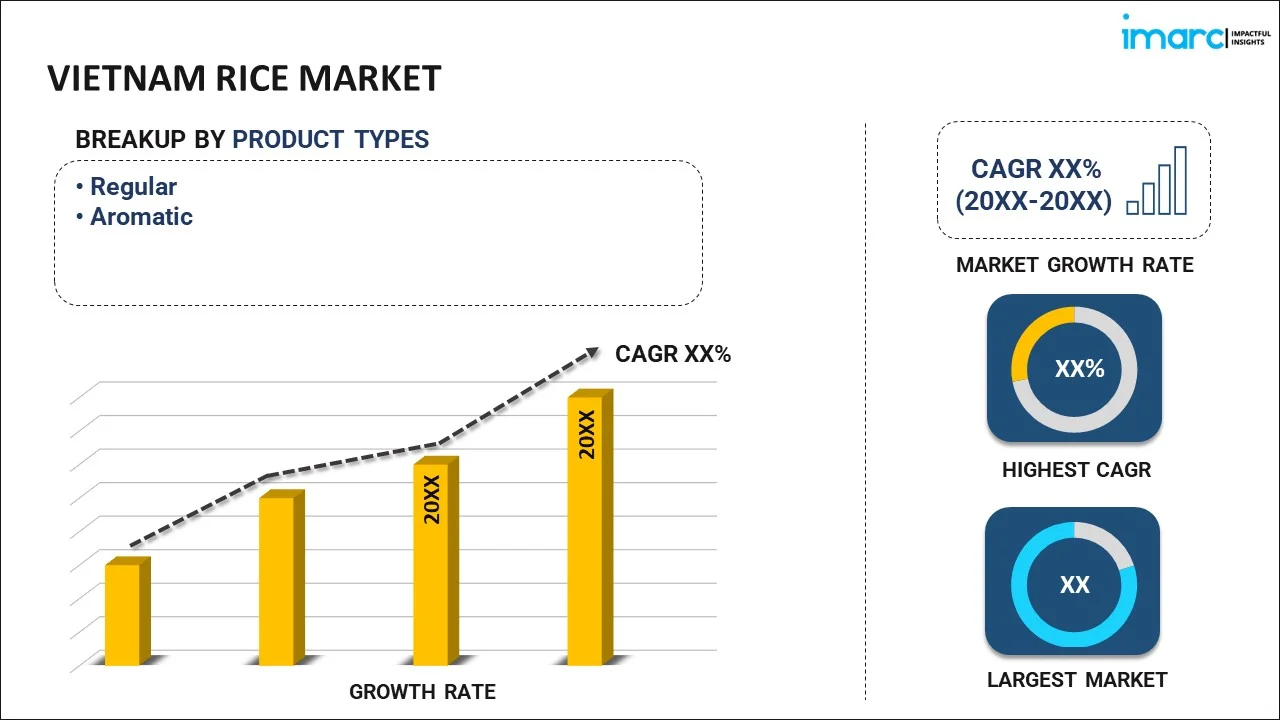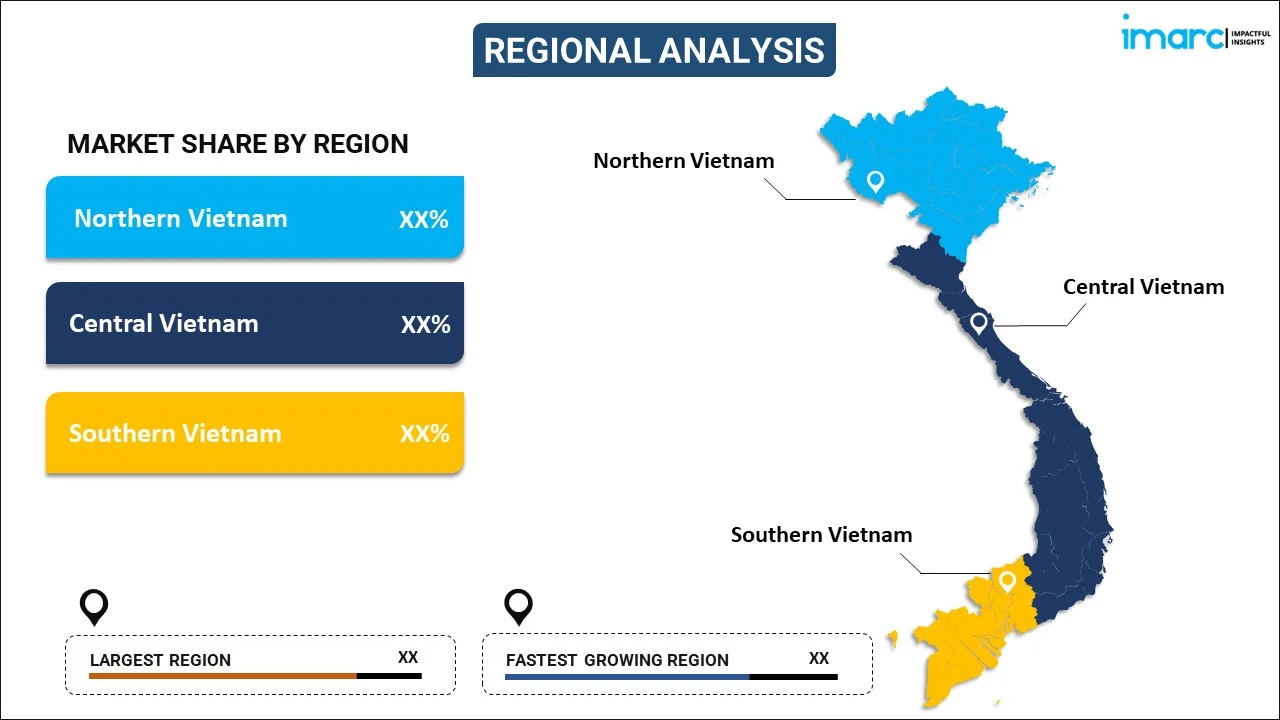
Vietnam Rice Market Report by Product Type (Regular, Aromatic), Type (Red Rice, Arborio Rice, Black Rice, Grain Fragrance Rice, Brown Rice, Rosematta Rice, Grain Parboiled Rice, Sushi Rice, and Others), Grain Size (Long Grain, Medium Grain, Short Grain), Distribution Channel (Offline Stores, Online Stores), Application (Food, Feed, and Others), and Region 2025-2033
Market Overview:
Vietnam rice market size reached USD 1.2 Billion in 2024. Looking forward, IMARC Group expects the market to reach USD 2.3 Billion by 2033, exhibiting a growth rate (CAGR) of 7.33% during 2025-2033. The availability of abundant fertile land and favorable climatic conditions, rising adoption of advanced technologies in rice farming practices, and continuous research and development (R&D) activities in rice breeding and agronomy represent some of the key factors driving the market. In 2023, Vietnam was the world’s third biggest rice exporter, based on World Bank data. Its rice shipments totaled USD 4.37 Billion, making up 10.7% of global exports.
|
Report Attribute
|
Key Statistics
|
|---|---|
|
Base Year
|
2024
|
|
Forecast Years
|
2025-2033
|
|
Historical Years
|
2019-2024
|
|
Market Size in 2024
|
USD 1.2 Billion |
|
Market Forecast in 2033
|
USD 2.3 Billion |
| Market Growth Rate 2025-2033 | 7.33% |
Rice, scientifically known as Oryza sativa, is a cereal grain that belongs to the Poaceae family. It is low in fat and fortified with essential vitamins and minerals, including B vitamins, iron, and magnesium. It is available in various textures, such as sticky, glutinous, fluffy, and separate depending on the type and cooking method. It is naturally gluten-free, making it suitable for individuals with gluten sensitivities or celiac disease. Its fiber content contributes to a feeling of fullness, aiding in portion control and weight management. It can be used in a wide range of dishes, ranging from savory to sweet, making it a versatile ingredient in various cuisines.
Vietnam Rice Market Trends:
Global Recognition Elevating Rice Image
Vietnam's rice industry received a major boost when one of its varieties was named the best in the world in 2023. This recognition has intensified focus on quality improvement and brand development. Exporters are now positioning select offerings under premium labels, supported by better post-harvest handling and aroma retention techniques. This momentum is encouraging farmers and cooperatives to invest in modern tools and systems to enhance consistency and meet international standards. Precision seeding, smart irrigation, and satellite monitoring are increasingly common in major production zones. These advances reflect a broader national shift toward agricultural technology, signaling that Vietnam is no longer just chasing volume but is serious about high-end markets and traceability demands.
Sustainable Practices Anchoring Long-Term Growth
In provinces like Long An and Can Tho, farmers are pivoting toward sustainable models that prioritize water efficiency and biodiversity. Techniques like alternate wetting and drying (AWD), organic soil enrichment, and integrated pest control are gaining ground. These practices are often reinforced by government-backed training and international pilot projects. Buyers from Europe and Asia are also starting to favor these eco-conscious producers, provided that traceability is intact. Certifications linked to low carbon output and chemical-free production are becoming valuable selling points. Vietnam premium rice is increasingly recognized not just as a premium product, but as a sustainable one, helping the country compete not just on price or volume, but also on environmental responsibility.
World’s Cheapest White Rice Source
As of mid-2025, Vietnam has emerged as the lowest-cost supplier of white rice globally, with FOB prices averaging just $399/mt. This is largely driven by high output, favorable weather, and efficient logistics out of ports like Ho Chi Minh City. These cost advantages have created new momentum in markets such as the Middle East and parts of Africa, where budget constraints often determine sourcing decisions. At the same time, traders report increased volume movements, supported by timely harvesting cycles and minimal domestic procurement disruptions. Based on rice export statistics, shipments in the first half of the year have already surpassed previous quarterly records. For many buyers, rice Vietnam has become a go-to not just for price, but for reliability and supply continuity.
Vietnam Rice Market Segmentation:
IMARC Group provides an analysis of the key trends in each segment of the market, along with forecasts at the country level for 2025-2033. Our report has categorized the market based on product type, type, grain size, distribution channel, and application.
Product Type Insights:

- Regular
- Aromatic
The report has provided a detailed breakup and analysis of the market based on the product type. This includes regular and aromatic.
Type Insights:
- Red Rice
- Arborio Rice
- Black Rice
- Grain Fragrance Rice
- Brown Rice
- Rosematta Rice
- Grain Parboiled Rice
- Sushi Rice
- Others
A detailed breakup and analysis of the market based on the type have also been provided in the report. This includes red rice, arborio rice, black rice, grain fragrance rice, brown rice, rosematta rice, grain parboiled rice, sushi rice, and others.
Grain Size Insights:
- Long Grain
- Medium Grain
- Short Grain
The report has provided a detailed breakup and analysis of the market based on the grain size. This includes long grain, medium grain, and short grain.
Distribution Channel Insights:
- Offline Stores
- Online Stores
A detailed breakup and analysis of the market based on the distribution channel have also been provided in the report. This includes offline stores and online stores.
Application Insights:
- Food
- Feed
- Others
The report has provided a detailed breakup and analysis of the market based on the application. This includes food, feed, and others.
Regional Insights:

- Northern Vietnam
- Central Vietnam
- Southern Vietnam
The report has also provided a comprehensive analysis of all the major regional markets, which include Northern Vietnam, Central Vietnam, and Southern Vietnam.
Competitive Landscape:
The market research report has also provided a comprehensive analysis of the competitive landscape in the market. Competitive analysis such as market structure, key player positioning, top winning strategies, competitive dashboard, and company evaluation quadrant has been covered in the report. Also, detailed profiles of all major companies have been provided.
Vietnam Rice Market News:
- In April 2025, a Vietnamese vessel carrying 12,700 tonnes of Atop rice arrived at Chattogram Port under a government-to-government agreement, according to Bangladesh’s food ministry. The delivery is part of Bangladesh’s contract to import 100,000 tonnes from Vietnam. So far, 60,000 tonnes have been received. Vietnam’s timely exports are playing a crucial part in supporting Bangladesh’s food security and market stability efforts.
- In March 2025, Vietnamese Japonica rice gained traction in Japan for its quality and affordability. Spice House Co. in Kanagawa reported rising demand, with five-kilo bags selling for JPY 3,240 (USD 21.80), undercutting Japanese-grown rice by over JPY 700. Resembling Japanese rice in taste and texture, the Vietnamese variety appeals to cost-conscious consumers. High demand has led to stock shortages, prompting the store to restrict sales to one bag per customer.
- In October 2024, Vietnam officially launched RiceMoRe, a digital rice monitoring and reporting system co-developed by the International Rice Research Institute and the Department of Crop Production. Introduced at a national conference by the Ministry of Agriculture, RiceMoRe supports real-time tracking and reporting to reduce emissions and boost sustainability in rice production. The system is now managed by Vietnam’s Center for Digital Transformation and Agricultural Statistics.
- In September 2024, Vietnam's Ministry of Agriculture and the International Rice Research Institute held a review meeting in Soc Trang for the 1-Million Hectare High Quality and Low Emission Rice Program. A pilot farm harvesting event coincided with the session. Seven pilot models were launched in five Mekong Delta provinces during the summer-autumn of 2024, targeting sustainable rice production and reduced emissions across 12 provinces in the region.
- In September 2024, Vietnamese farmers in the Mekong Delta received nearly USD 40 Million through carbon credit payments under the “1 Million Hectares High Quality and Low-Carbon Rice” initiative. Backed by the Transformative Carbon Asset Facility and the World Bank, the project supports sustainable rice farming and emission reduction. A pilot phase was discussed by the Ministry of Agriculture, following approval of a Project Idea Note with USD 33.3 Million in initial funding.
Vietnam Rice Market Report Coverage:
| Report Features | Details |
|---|---|
| Base Year of the Analysis | 2024 |
| Historical Period | 2019-2024 |
| Forecast Period | 2025-2033 |
| Units | Billion USD |
| Scope of the Report | Exploration of Historical Trends and Market Outlook, Industry Catalysts and Challenges, Segment-Wise Historical and Future Market Assessment:
|
| Product Types Covered | Regular, Aromatic |
| Types Covered | Red Rice, Arborio Rice, Black Rice, Grain Fragrance Rice, Brown Rice, Rosematta Rice, Grain Parboiled Rice, Sushi Rice, Others |
| Grain Sizes Covered | Long Grain, Medium Grain, Short Grain |
| Distribution Channels Covered | Offline Stores, Online Stores |
| Applications Covered | Food, Feed, Others |
| Regions Covered | Northern Vietnam, Central Vietnam, Southern Vietnam |
| Customization Scope | 10% Free Customization |
| Post-Sale Analyst Support | 10-12 Weeks |
| Delivery Format | PDF and Excel through Email (We can also provide the editable version of the report in PPT/Word format on special request) |
Key Benefits for Stakeholders:
- IMARC’s industry report offers a comprehensive quantitative analysis of various market segments, historical and current market trends, market forecasts, and dynamics of the Vietnam rice market from 2019-2033.
- The research report provides the latest information on the market drivers, challenges, and opportunities in the Vietnam rice market.
- Porter's five forces analysis assist stakeholders in assessing the impact of new entrants, competitive rivalry, supplier power, buyer power, and the threat of substitution. It helps stakeholders to analyze the level of competition within the Vietnam rice industry and its attractiveness.
- Competitive landscape allows stakeholders to understand their competitive environment and provides an insight into the current positions of key players in the market.
Key Questions Answered in This Report
The rice market in the Vietnam was valued at USD 1.2 Billion in 2024.
The Vietnam rice market is projected to exhibit a CAGR of 7.33% during 2025-2033, reaching a value of USD 2.3 Billion by 2033.
The Vietnam rice market is driven by strong global demand, government support, favorable climate, high-yielding varieties, and improved farming practices. Trade agreements and competitive pricing boost exports, while rising food security concerns and regional shortages increase demand. Technological adoption and investment in logistics also strengthen Vietnam’s position in global markets.
Yes, Vietnam is a major rice exporter globally. Vietnam exported 7,500 metric tons of rice in 2024–25, according to official export data. With rice exports valued at $4.19 billion, the country ranks fourth globally, contributing 10.7% to the world’s total rice exports.
Need more help?
- Speak to our experienced analysts for insights on the current market scenarios.
- Include additional segments and countries to customize the report as per your requirement.
- Gain an unparalleled competitive advantage in your domain by understanding how to utilize the report and positively impacting your operations and revenue.
- For further assistance, please connect with our analysts.
 Request Customization
Request Customization
 Speak to an Analyst
Speak to an Analyst
 Request Brochure
Request Brochure
 Inquire Before Buying
Inquire Before Buying




.webp)




.webp)












